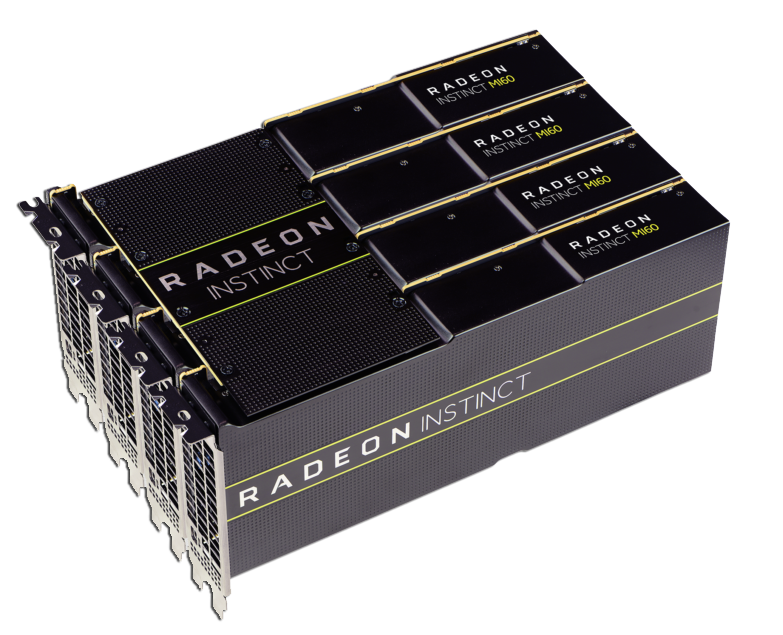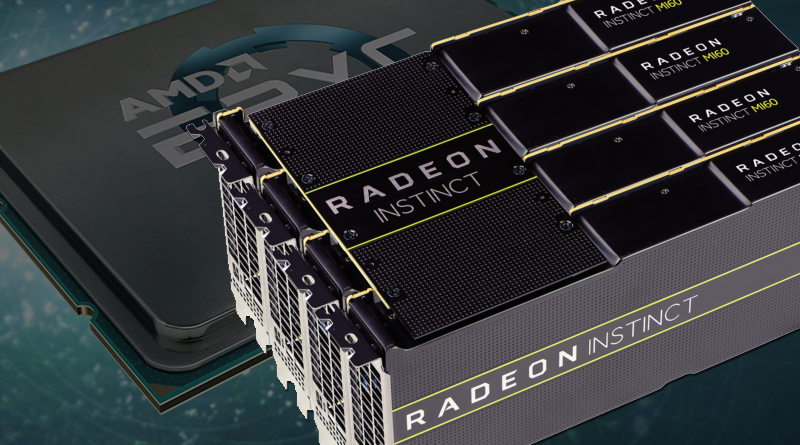AMD ประกาศความเป็นผู้นำผลิตภัณฑ์ยุคใหม่ ด้วยโปรเซสเซอร์ AMD EPYC™ และกราฟิกการ์ด Radeon™ Instinct พร้อมเปิดใช้งานซูเปอร์คอมพิวเตอร์ El Capitan
AMD ประกาศความเป็นผู้นำผลิตภัณฑ์ยุคใหม่ ด้วยโปรเซสเซอร์ AMD EPYC™
และกราฟิกการ์ด Radeon™ Instinct พร้อมเปิดใช้งานซูเปอร์คอมพิวเตอร์ El Capitan
ณ ศูนย์วิจัยแห่งชาติ Lawrence Livermore ที่ก้าวข้ามการประมวลผลระดับ 2 Exaflop
 ด้วยความร่วมมือกับ HPE มีเป้าหมายเพื่อความเป็นผู้นำในการประมวลผล HPC และ AI จะเริ่มใช้งานในปี 2566
ด้วยความร่วมมือกับ HPE มีเป้าหมายเพื่อความเป็นผู้นำในการประมวลผล HPC และ AI จะเริ่มใช้งานในปี 2566
ซูเปอร์คอมพิวเตอร์ El Capitan เป็นซูเปอร์คอมพิวเตอร์ที่ใช้ชิปประมวลผลและกราฟิกการ์ด AMD ที่มีประสิทธิภาพสูงเป็นแห่งที่ 2 ที่ใช้งานอยู่ในสหรัฐอเมริกา และได้รับการคาดการณ์ว่าจะมีประสิทธิภาพมากกว่าซูเปอร์คอมพิวเตอร์ที่เร็วที่สุด 200 อันดับแรกในปัจจุบัน —
กรุงเทพฯ, ประเทศไทย – 6 มีนาคม 2563 – AMD (NASDAQ: AMD) ร่วมมือกับศูนย์วิจัยแห่งชาติ Lawrence Livermore National Laboratory (LLNL) และ HPE ประกาศว่าซูเปอร์คอมพิวเตอร์ El Capitan ขนาดประมวลผลขนาด Exascale ตั้งอยู่ ณ ศูนย์วิจัยแห่งชาติ Lawrence Livermore ใช้โปรเซสเซอร์ AMD EPYC™, กราฟิกการ์ด AMD Radeon™ Instinct และโอเพ่นซอร์ส AMD ROCm ในการขับเคลื่อนประสิทธิภาพการประมวลผล
ทั้งนี้ คาดว่าซูเปอร์คอมพิวเตอร์ El Capitan จะเริ่มใช้งานในปี 2566 พร้อมทั้งได้รับการคาดการณ์ว่าจะเป็นซูเปอร์คอมพิวเตอร์ที่เร็วที่สุดในโลก ด้วยประสิทธิภาพในการประมวลผลแบบ Double-Precision มากกว่า 2 Exaflop ด้วยประสิทธิภาพในการประมวลผลที่กำหนดไว้นี้จะเข้ามาช่วยสนับสนุนการทำงานของหน่วยงานด้านการบริหารความปลอดภัยทางนิวเคลียร์แห่งชาติ หรือ National Nuclear Security Administration (NNSA) ในภารกิจด้านการรับรองความปลอดภัย ความมั่นคง และความเชื่อมั่นในการจัดการนิวเคลียร์ของประเทศ
โดยโหนดที่ขับเคลื่อนประสิทธิภาพด้วยผลิตภัณฑ์ของ AMD จะได้รับการปรับปรุงให้สามารถเพิ่มความเร็วในการประมวลผลปริมาณงานของปัญญาประดิษฐ๋ (Artificial Intelligence หรือ AI) และ งานด้านMachine Learning หรือ ML เพื่อทำให้สามารถนำ AI และ ML มาใช้งานในการทำวิจัย กระบวนการในการประมวลผล และการวิเคราะห์ที่เป็นประโยชน์ต่อพันธกิจของ NNSA
นายฟอเรสต์ นอร็อด รองประธานอาวุโส และผู้จัดการทั่วไป กลุ่มธุรกิจ Datacenter และ Embedded Systems บริษัท AMD กล่าวว่า “ซูเปอร์คอมพิวเตอร์ El Capitan จะผลักดันความก้าวหน้าด้านเทคโนโลยีอย่างที่ไม่เคยเกิดขึ้นมาก่อนในการประมวลผลรูปแบบ HPC และ AI ที่ขับเคลื่อนประสิทธิภาพในการประมวลผลด้วยโปรเซสเซอร์ AMD EPYC และกราฟิกการ์ด AMD Radeon Instinct รุ่นต่อไป ด้วยรากฐานที่แข็งแกร่งของเราในด้านการประมวลผลประสิทธิภาพสูง และการเพิ่มความสามารถด้านการประมวลผลข้อมูลแบบเชื่อมโยง Transformative Coherency ทำให้ AMD กำลังเปิดใช้งานคอมมิวนิตี้ NNSA Tri-Lab – LLNL และศูนย์วิจัยแห่งชาติ Los Alamos และ Sandia เพื่อบรรลุเป้าหมายสำคัญ และสนับสนุนความก้าวหน้าทางเทคโนโลยี AI ใหม่ ๆ ในอุตสาหกรรม เรารู้สึกภูมิใจอย่างมากในการทำงานที่ยอดเยี่ยมร่วมกับ HPE และ NNSA และหวังว่าจะส่งมอบซูเปอร์คอมพิวเตอร์ที่ทรงพลังที่สุดในโลกได้สำเร็จในช่วงต้นปี 2566”
 เทคโนโลยี AMD ที่เข้ามาขับเคลื่อนประสิทธิภาพซูเปอร์คอมพิวเตอร์ El Capitan
เทคโนโลยี AMD ที่เข้ามาขับเคลื่อนประสิทธิภาพซูเปอร์คอมพิวเตอร์ El Capitan
AMD นำประสบการณ์จากอุตสาหกรรมการประมวลประสิทธิภาพสูง และการพัฒนาโปรเซสเซอร์ และกราฟิกการ์ดรุ่นปัจจุบันมาใช้ในการพัฒนาซูเปอร์คอมพิวเตอร์ El Capitan ซึ่งจะช่วยให้ระบบต่าง ๆ มีประสิทธิภาพสูงสุด และใช้งานง่าย
เทคโนโลยี AMD ในซูเปอร์คอมพิวเตอร์ El Capitan ประกอบด้วย
- โปรเซสเซอร์ AMD EPYC รุ่นใหม่ โค้ดเนมว่า “Genoa” ซึ่งใช้สถาปัตยกรรม “Zen 4” โดยโปรเซสเซอร์จะรองรับหน่วยความจำ และระบบ I/O รุ่นต่อไป สำหรับเวิร์คโหลด AI และ HPC
- กราฟิกการ์ด AMD Radeon Instinct รุ่นใหม่ที่อิงตามสถาปัตยกรรมที่ได้รับการพัฒนาใหม่ สำหรับการประมวลผลเวิร์คโหลดอย่าง HPC และ AI โดยกราฟิกการ์ดนี้จะใช้หน่วยความจำแบนด์วิดธ์สูงรุ่นใหม่ และได้รับการออกแบบมาเพื่อเพิ่มประสิทธิภาพด้านการเรียนรู้ให้มากที่สุด
- สถาปัตยกรรมรุ่น 3 3rd Gen AMD Infinity ให้แบนด์วิดธ์สูง และความหน่วงต่ำระหว่างการเชื่อมต่อของกราฟิกการ์ด Radeon Instinct จำนวน 4 ตัว และโปรเซสเซอร์ AMD EPYC จำนวน 1 ตัว ที่ประกอบอยู่ในแต่ละโหนดของซูเปอร์คอมพิวเตอร์ El Capitan ด้วยสถาปัตยกรรม 3rd Gen AMD Infinity ยังช่วยเรื่องการเข้าถึงหน่วยความจำของโปรเซสเซอร์ และกราฟิกการ์ดจะทำให้โปรแกรมเมอร์เข้าถึงการประมวลผลมีประสิทธิภาพมากยิ่งขึ้น
- โอเพ่นซอร์สที่ได้รับการพัฒนาอย่าง ROCm ในเวอร์ชั่นใหม่นี้มีความหลากหลายในการทำงาน ได้รับการพัฒนาให้สามารถรองรับประสิทธิภาพการทำงานร่วมกันกับโปรเซสเซอร์ และกราฟิการ์ดของ AMD ช่วยปลดล็อคประสิทธิภาพออกมาได้สูงสุด
นายบิล โกลด์สตีน ผู้อำนวยการศูนย์วิจัยแห่งชาติ Lawrence Livermore กล่าวว่า “ด้วยการขับเคลื่อนประสิทธิภาพในการประมวลผลด้วยเทคโนโลยีโปรเซสเซอร์ และกราฟิกการ์ดขั้นสูงของ AMD ทำให้เราได้รับประสิทธิภาพในการประมวลผลในแบบที่ไม่เคยพบมาก่อน ซึ่งจะเข้ามาช่วยอเมริกาในการรักษาตำแหน่งในระดับโลกด้านการประมวลผลประสิทธิภาพสูง และเป็นตัวอย่างที่ดีของความมุ่งมั่นที่จะบำรุงรักษาระบบต่อต้านนิวเคลียร์ของประเทศ การประกาศความร่วมมือในครั้งนี้เป็นตัวอย่างที่แสดงให้เห็นว่ารัฐบาล และภาคอุตสาหกรรมสามารถทำงานร่วมกันเพื่อผลประโยชน์ของประเทศได้”
นายปีเตอร์ อันกาโร รองประธานอาวุโสและผู้จัดการทั่วไป, HPC and Mission Critical Solutions (MCS) ของ HPE กล่าวว่า “เรายินดีอย่างยิ่งที่ได้ร่วมงานกับ AMD นำสถาปัตยกรรม HPE’s Cray Shasta
ใช้งานร่วมกับโปรเซสเซอร์ AMD EPYC™ และกราฟิกการ์ด AMD Radeon™ Instinct นำเสนอความเป็นผู้นำด้านเทคโนโลยีในการให้การสนับสนุน พันธกิจสำคัญด้าน HPC และ AI ให้กับศูนย์วิจัยแห่งชาติ Lawrence Livermore” และเสริมว่า “ปีที่แล้วเราได้รับคัดเลือกจากสามหน่วยงานในสหรัฐฯ เพื่อการใช้งานระบบประมวลผลระดับ Exascale รวมถึง The U.S. Department of Energy’s Frontier at Oak Ridge National Laboratory (กระทรวงพลังงานของสหรัฐอเมริกาที่ตั้งอยู่ที่ศูนย์วิจัยแห่งชาติ Oak Ridge) ด้วยระบบ HPE และเทคโนโลยี รวมถึงโปรเซสเซอร์ AMD และกราฟิกการ์ด ได้กลายมาเป็นโซลูชั่นที่มีความโดดเด่นเหมาะประสิทธิภาพระดับสูงและการประมวลผลระดับ Exascale และรอคอยที่จะสืบสานความร่วมมือกันต่อไปเพื่อการรังสรรค์ความแข็งแกร่งให้กับนวัตกรรมต่อไป
Additional Resources
- AMD Exascale Computing Technologies
- HPE Announcement
- Lawrence Livermore Labs Announcement
- Follow AMD datacenter developments on Twitter @AMDServer
About AMD
For 50 years AMD has driven innovation in high-performance computing, graphics and visualization technologies ― the building blocks for gaming, immersive platforms and the datacenter. Hundreds of millions of consumers, leading Fortune 500 businesses and cutting-edge scientific research facilities around the world rely on AMD technology daily to improve how they live, work and play. AMD employees around the world are focused on building great products that push the boundaries of what is possible. For more information about how AMD is enabling today and inspiring tomorrow, visit the AMD (NASDAQ:AMD) website, blog, Facebook and Twitter pages.
—30—
Cautionary Statement
This press release contains forward-looking statements concerning Advanced Micro Devices, Inc. (AMD) including the features, functionality, availability, timing, deployment and expectations of an EPYC™ CPU and Radeon™ Instinct GPU powered exascale class supercomputer with open source AMD ROCm heterogeneous computing software, which are made pursuant to the Safe Harbor provisions of the Private Securities Litigation Reform Act of 1995. Forward-looking statements are commonly identified by words such as “would,” “may,” “expects,” “believes,” “plans,” “intends,” “projects” and other terms with similar meaning. Investors are cautioned that the forward-looking statements in this presentation are based on current beliefs, assumptions and expectations, speak only as of the date of this presentation and involve risks and uncertainties that could cause actual results to differ materially from current expectations. Such statements are subject to certain known and unknown risks and uncertainties, many of which are difficult to predict and generally beyond AMD’s control, that could cause actual results and other future events to differ materially from those expressed in, or implied or projected by, the forward-looking information and statements. Material factors that could cause actual results to differ materially from current expectations include, without limitation, the following: Intel Corporation’s dominance of the microprocessor market and its aggressive business practices; the ability of third party manufacturers to manufacture AMD’s products on a timely basis in sufficient quantities and using competitive technologies; expected manufacturing yields for AMD’s products; AMD’s ability to introduce products on a timely basis with features and performance levels that provide value to its customers while supporting and coinciding with significant industry transitions; AMD’s ability to generate sufficient revenue and operating cash flow or obtain external financing for research and development or other strategic investments; the loss of a significant customer; AMD’s ability to generate revenue from its semi-custom SoC products; global economic uncertainty; political, legal and economic risks and natural disasters; government actions and regulations such as export administration regulations, tariffs and trade protection measures may limit our ability export our products to certain customers; potential security vulnerabilities; potential IT outages, data loss, data breaches and cyber-attacks; the ability of GLOBALFOUNDRIES Inc. to satisfy AMD’s manufacturing requirements; uncertainties involving the ordering and shipment of AMD’s products; quarterly and seasonal sales patterns; the restrictions imposed by agreements governing AMD’s notes and the secured credit facility; the competitive markets in which AMD’s products are sold; the potential dilutive effect if the 2.125% Convertible Senior Notes due 2026 are converted; the market conditions of the industries in which AMD products are sold; AMD’s reliance on third-party intellectual property to design and introduce new products in a timely manner; AMD’s reliance on third-party companies for the design, manufacture and supply of motherboards, software and other computer platform components; AMD’s reliance on Microsoft Corporation and other software vendors’ support to design and develop software to run on AMD’s products; and AMD’s reliance on third-party distributors and add-in-board partners. Investors are urged to review in detail the risks and uncertainties in AMD’s Securities and Exchange Commission filings, including but not limited to AMD’s Annual Report on Form 10-K for the year ended December 28, 2019.
AMD, the AMD Arrow logo, EPYC, Radeon Instinct, and combinations thereof, are trademarks of Advanced Micro Devices, Inc. Other names are for informational purposes only and may be trademarks of their respective owners.

